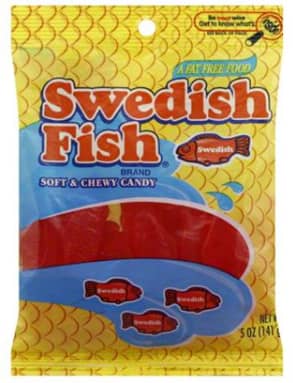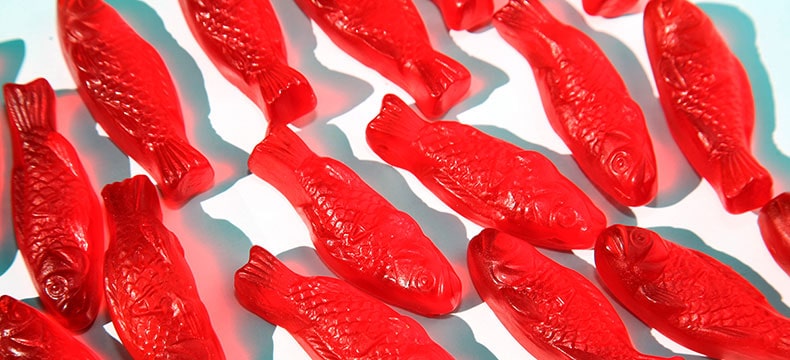Swedish Fish is a popular chewy fish-shaped candy developed by a Swedish candy maker that’s been in the US market since the 1950s.1 Originally colored red, they now come in a variety of colors and flavors such as lemon-lime and orange.
Are they vegan? Most Swedish Fish are 100% vegan. As of now, most only use carnauba wax as an edible film—to add cohesion and shine to coatings.2 However, some are made with beeswax in addition to carnauba wax.3 But, these are few and far between. You’ll just have to check the label before purchasing.
So far, I’ve only run across beeswax listed as an ingredient on the pegged bags. These are the bags with the small hole on the top center. They are found in gas stations and vending machines (picture below).
As you can see, they contain carnauba wax instead of beeswax.
Basic Ingredients (Vegan Edition)
According to Smart Label, the current ingredients for Swedish Fish (assorted flavors) include:4
- Sugar
- Invert sugar
- Corn syrup
- Modified food starch
- Citric acid
- White mineral oil
- Natural and artificial flavors
- Carnauba wax
- Red 40
- Yellows 5 and 6
- Blue 1
Basic Ingredients (Non-Vegan Edition)

Ingredients include:3
- Sugar
- Invert sugar
- Corn syrup
- Modified food starch
- Citric acid
- Palm kernel oil
- Natural and artificial flavors
- Carnauba wax
- Red 40
- Beeswax
Note this version also contains palm oil which is another ingredient that’s problematic at last for some vegans.
Why Swedish Fish Are Largely Considered Vegan
Swedish Fish Don’t Contain Gelatin or Egg Albumen
Gelatin and egg albumen are among the few ingredients in PETA’s list of animal-derived ingredients that are always off-limits to vegans.5
Gummy candies like Swedish Fish often fall into a category known as aerated candy.
Corn syrup serves as a foundation for candies like jelly beans, marshmallows, and gumdrops. The candy can be aerated a few different ways:
- Physically via what’s known as pulling
- Chemically via the addition of sodium bicarbonate
- The use of foams for structure
The foam means of aeration is where egg albumen comes into play. Marshmallows are a notable example of candy often made with egg white.6
Aerated candy often makes use of gelling agents such as gelatin.
Gelatin is a translucent, flavorless, colorless food additive, derived from collagen—the protein found abundantly in animals.
Industrially, gelatin is usually made from animal by-products of the meat and leather industries. Most gelatin tends to be derived from pork skins, cattle hides, and the bones of cattle and pork.7
The gummy texture can be further enhanced by adding gelling agents like gelatin.8
Fortunately, many candies use other gelling agents like various starches, gums, and pectin which are added to the sugar content. The gelling agents help stabilize the candy, bind water, and add elasticity.9
Like egg albumen, gelatin can also be used as an aerator to help achieve a chewy texture.
So yeah, gelatin and egg albumen are both off-limits for vegans. Luckily, neither are used in Swedish Fish.
Most Swedish Fish Contain Carnauba Wax Instead of Beeswax
According to PETA, beeswax is sometimes used in Swedish Fish.10
In all my dealings with the product, I’ve rarely found any Swedish Fish to include the additive. Perhaps it’s a dated ingredient that they’re phasing out.
Purified beeswax is commonly used in food production as well as cosmetics and pharmaceuticals.
It’s often used in small quantities to act as a glazing agent, which prevents water loss and adds surface protection.
It’s what’s known as an edible film. There are a number of edible films used in food production some of which are vegan.
Non-vegan edible films include beeswax, chitosan (shellfish), whey protein isolate and casein.11
Vegan edible films include alginate (gum), zein (corn), and carnauba wax.12
These days, it seems Swedish Fish mostly make use of carnauba wax.
Carnauba wax aka Brazil wax or palm wax is an ingredient derived from the leaves of the palm Copernicia prunifera, a plant native to Brazil.13
It’s 100% vegan-friendly.
Swedish Fish Contain Red 40 Instead of Red 4
The food industry uses a number of food coloring agents to enhance the visual appeal of food products. One popular food colorant is Red 4, which is derived from beetles.
Red 4 or carmine is a bright-red food coloring agent derived from carminic acid which is a compound found abundantly in certain types of beetles.14
It imparts basically the same color as Red 40 and shares a similar name, which is why the two often get confused.
Red 40 aka Allura red is another popular red food colorant. Red 40 is an azo dye which is a class of food coloring agents that derive from petroleum and can even be acquired from strawberries.15
So, it’s Red 40 that’s used in Swedish Fish and it’s 100% vegan-friendly.
Blue 1 and Yellows 5 and 6 Are Vegan
Yellow 5 (tartrazine) and Yellow 6 (Sunset Yellow) are also azo dyes like Red 40 so they’re petroleum-derived.
Yellow 5 is a lemon-yellow color that was first made from coal tar but nowadays tends to be produced as a byproduct of the petroleum industry. So, it’s not derived from animals and is suitable for vegans.
Yellow 6 is also petroleum-derived, and like Red 40, can be produced from strawberries.16,17
Blue 1 aka Brilliant Blue FCF is a synthetic food colorant used in food products, medicines, dietary supplements, and cosmetics.18
It’s really bright blue so it’s a favorite for candy like blue raspberry, etc.
It’s chemically synthesized from non-animal-derived precursors, so it’s considered vegan.19
That pretty much sums it up for Swedish Fish. Thanks for reading. You may also want to check out the following related articles:*
- Are Dum Dums Vegan?
- List of Vegan-Friendly NOW and LATER Flavors
- Is Mike and Ike Candy Really Vegan?
- Are SweeTarts Vegan?
- Are Tootsie Rolls Vegan? What About Tootsie Pops?
- Are Jolly Ranchers Vegan?
- Are Macarons and Macaroons Vegan?
- Is Store-Bought Granola Vegan?
References
- “A Brief History of Swedish Fish”. mentalfloss.com. http://mentalfloss.com/article/23125/brief-history-swedish-fish
- Understanding Food: Principles and Preparation (Page 493). Amy Brown – Wadsworth Cengage Learning – 2011
- Swedish Fish-red-6g Piece-5 Oz Peg Bag-ea https://www.foodservice-snacks-desserts.com/productsandbrands/OurBrands/SwedishFish/productpage?p=6367&brand=SwedishFish
- Swedish Fish Bags Original Soft & Chewy Assorted Candy. https://smartlabel.mondelezinternational.com/70462098662#
- Animal-derived Ingredients Resource | Living. https://www.peta.org/living/food/animal-ingredients-list/
- Alexander RJ. Sweeteners: Nutritive. Eagan Press, 1998.
- “Natural Health Products Ingredients Database: Hydrolyzed Collagen”. Government of Canada, Health Canada, Health Products and Food Branch, Natural Health Products Directorate. 12 June 2013.
- Understanding Food: Principles and Preparation (Page 519). Amy Brown – Wadsworth Cengage Learning – 2011
- Pszczola DE. Ingredient developments for confections. Food Technology 51(9):70, 1997.
- Which Candies Are Vegan? https://www.peta.org/about-peta/faq/which-candies-are-vegan/
- Buonocore GG, A Conte, and MA Del Nobile. Use of mathematical model to describe the barrier properties of edible films. Journal of Food Science 70(2):E142–E147, 2005.
- Perez-Gago MB, M Serra, M Alonso, M Mateos, and MA del Rio. Eff ect of whey protein- and hydroxyproply methylcellulosebased edible composite coatings on color change of fresh apples. Postharvest Biology and Technology 36(1):77–85, 2005.
- Steinle, J. Vernon (September 1936). “Carnauba wax: an expedition to its source”. Industrial & Engineering Chemistry. 28 (9): 1004–1008.
- Bug-Based Food Dye Should Be Exterminated, Says CSPI. https://cspinet.org/news/bug-based-food-dye-should-be-exterminated-says-cspi-20060501
- Potera, C., 2010. Diet and nutrition: the artificial food dye blues. Environ Health Perspect. 118 (10), A428–A431.
- Committee on Food Chemicals Codex (2003). Food chemicals codex (5th ed.). Washington, DC: National Academy Press. ISBN 9780309088664.
- Diet and Nutrition: The Artificial Food Dye Blues. Carol Potera. Environ Health Perspect. 2010 Oct; 118(10): A428. https://www.ncbi.nlm.nih.gov/pmc/articles/PMC2957945/
- “FD&C Blue 1 (Brilliant Blue)”. International Association of Color Manufacturers.
- El Ali, Bassam M.; Bassam El Ali; Ali, Mohammad Farahat (2005). Handbook of industrial chemistry: organic chemicals. New York: McGraw-Hill. ISBN 978-0-07-141037-3.

